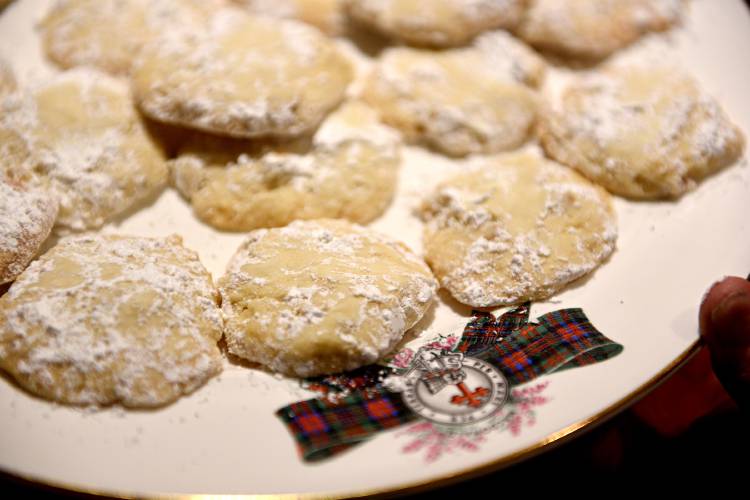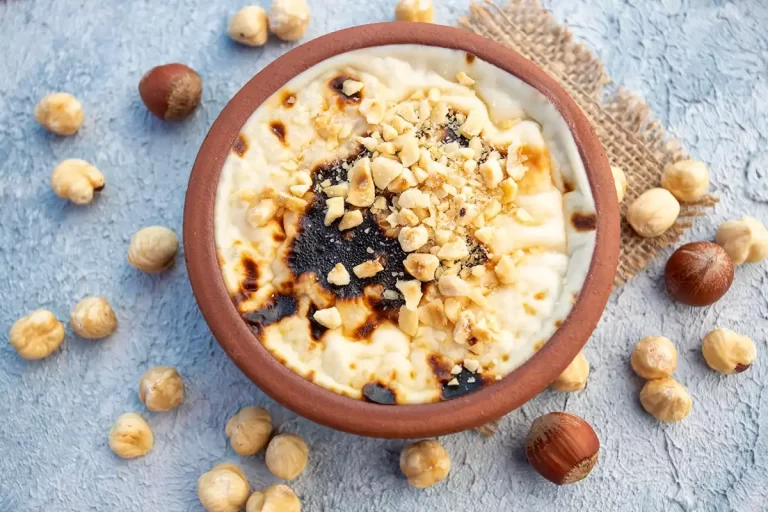SCOTTISH CLUB OF THE TWIN STATES – cooks up dishes familiar and distant

By Sarah Earle
Staff Writer, Valley News
Photos by Jennifer Hauck
Permission granted by Valley News, Lebanon, NH

Marion Burchard, of Hanover, N.H., right, samples porridge Anne Shivas made at Shivas’ home. Both are members of the Scottish Club of the Twin States. The porridge is served Aberdeen style, where after taking a spoonful of porridge you dip the spoon into a small bowl of milk.
Got a craving for Cullen skink? How about some howtowdie or a bit of flumph?
Well, you’re in luck. The Scottish Club of the Twin States has come out with a cookbook, and it’s filled with recipes for Scotland’s most distinctive and enduring dishes, from cock-a-leekie soup to nut roast. Haggis has its rightful place and there is no shortage of shortbread, but the book, a fundraiser for the group, also makes room for newer favorites and dishes that cross boundaries between cultures.
“Some of them are old family favorites from Scottish family and ancestors,” said Anne Shivas, who serves as treasurer of the Scottish Club and helped edit the cookbook. “(But) we did put in a lot of recipes that are not necessarily traditionally Scottish but are delicious. If you like cooking and you’re interested in food, you should find plenty to enjoy making.”
The names of the dishes alone are enjoyment enough. Along with the aforementioned favorites, there’s kedgeree, clapshot, tipsy laird trifle, forfar bridies, clootie dumpling … and let’s not forget pitcaithly bannock or baps.
“They have amazing names,” said Shivas, who moved to Norwich from Scotland about 20 years ago. “The names and ingredients reflect the culture and the history of Scotland.”
Kedgeree, a fish dish that often contains curry, for example, likely dates back to British colonial times when a large number of Scots served in India, Shivas said. And the Aberdeen buttery is the Scottish version of a croissant, probably cooked up during the “auld alliance” between Scotland and France near the end of the Middle Ages.

Anne Shivas, a member of the Scottish Club of the Twin States cuts a nut loaf she made at her home.
Trivia such as this is peppered throughout the book, which contains more than 100 recipes contributed by members of the Scottish Club — a group of about 40 families from around New Hampshire and Vermont but primarily from the Upper Valley. Shivas said she and her co-editors, Jean and John Lawe of Norwich, tried to offer special touches that both cooks and Scottish culture buffs would appreciate. Behind the wipe-able front cover is a watercolor painting by Nancy Dean of Norwich, and below many of the recipes’ titles are blurbs about their origins or their place in Scottish life. There are also extra pages for notes at the end of each chapter, and a spiral binding allows the pages to lie flat.
At the beginning of the book, there’s a page of cook’s notes describing ingredients that may be less than familiar to local cooks, such as treacle (molasses), bashed neeps (mashed turnip) and demerara (brown sugar).
Their names notwithstanding, the foods featured in the book probably won’t strike most New Englanders as especially foreign. Scottish cooking has influenced the region’s cuisine dating back to 1718, when the first group of Scots-Irish settlers arrived in America and proceeded to plant the first crop of potatoes in what is now Londonderry, N.H.
Scottish cooking does, however, have some distinctive characteristics and ingredients. First and foremost: oats, which make their way into everything from morning porridge to vegetable soup to fried trout.
“Oats grow really well in Scotland. They just were an absolute staple of the Scottish diet,” Shivas said.
Another Scottish staple is kale, which Scots were eating long before it became the darling of farmers markets everywhere. Allegedly introduced to the region by Oliver Cromwell when he invaded Scotland in 1650, the crop was so common that small home gardens became known as kailyards (kale is spelled kail in Scotland).
For lovers of kale/kail and the like, the cookbook has a substantial vegetarian section, featuring a popular fried potato dish called stovies, a nut roast that originates from Britain’s Princess Anne (Patron of the Scottish Rugby Union), even a vegetarian haggis.
Those whose taste runs more toward butter and sugar can find plenty to like as well. “(Scots) are very keen bakers and always were,” said Shivas, who particularly likes drop scones — an easy, pancake-like treat — for afternoon tea.
Other highlights of the sweets’ sections include a clootie dumpling, a traditional cold weather dumpling made with beef suet; sticky toffee pudding, a dish that’s trending in Scotland but doesn’t seem to have made its way to the states; and millionaire shortbread, a super-rich variation on one of the country’s best-loved cookies.

Scottish butter cookies made by Marion Burchard, of Hanover, N.H.
The mix of classic recipes and newer fare, of purely Scottish dishes and cross-cultural fusions, is in line with the culinary zeitgeist, Shivas said.
“Scottish culture is definitely re-embracing its traditional cooking these days, as Scots explore our roots, as well as borrowing widely from the many cultures — French, Italian and Indian in particular — that have fed into it,” Shivas said.
Shivas’ own family enjoys making nut roast for Thanksgiving and Christmas. She, like the other contributors, tried to share primarily recipes that were special to them and that they cook in their own homes.
The exception to that may be traditional haggis, a delicacy made with sheep’s organs (and oatmeal) stuffed in a sheep’s stomach.
“It’s not common to make it that way anymore,” Shivas said.
If you’re itching to try it but can’t get your hands on a sheep stomach, the Scottish Club has one shipped in every year for its Burns Night dinner.
If stomach isn’t really your thing, try this recipe for traditional cranachan:
CRANACHAN (Cream-Crowdie)
- 3 ounces pinhead oatmeal (or oats pulsed in a food processor)
- 6 tablespoons whisky
- 1 lb. raspberries
- 1 pint whipping cream
- 3 tablespoons honey
Toast the oatmeal in a thick-bottomed frying pan over gentle heat. Set aside to cool. Whip cream until firm, then fold together with the whisky and honey. Stir in the oatmeal and raspberries. Spoon into tall glasses and chill to serve. The cream must predominate.
SCOTTISH CLUB OF THE TWIN STATES.
on Facebook: www.facebook.com/SCOTSNHVT
Thank you to VALLEY NEWS, 24 Interchange Drive, West Lebanon, NH 03784; 603-298-8711, for kind permission to reprint information from their article about the SCOTTISH CLUB OF THE TWIN STATES.






